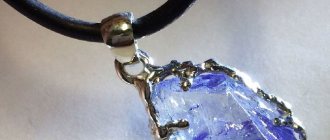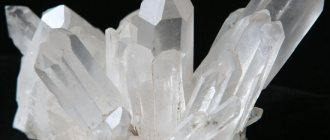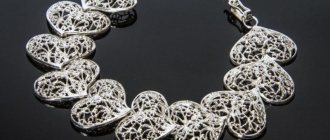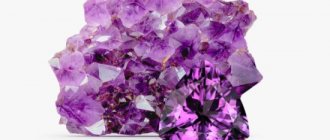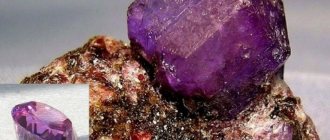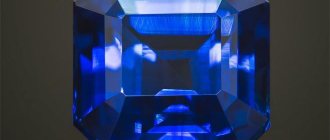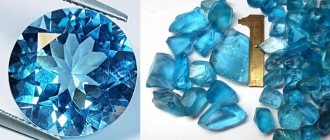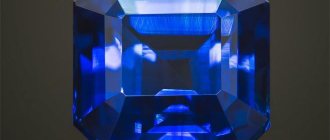Who found tanzanite
It is said that tanzanite was discovered by the Maasai Ndugu Juman Ngoma in the spring of 1966 in Tanzania, on the slope of Mount Kilimanjaro, Merelani Plateau, in an area called Kiteto. No, the Masai’s name was Ali Juyawati, others say. One way or another, it was a man from the Maasai tribe. The glorious warrior Ndugu Ngoma (or Ali Juyawati) brought a pebble to a merchant and jeweler - in case he bought it. I didn’t buy it, I decided it was a piece of painted glass.
Around the same time, adventurer and prospector Manuel De Souza was looking for rubies. He also encountered transparent bluish-purple stones, which he mistook for sapphires. Well, he can be forgiven, the prospector is not a gemologist.
True, the color of the stone seemed to him pale for sapphires. However, the prospector had business acumen, and he took the pebble to the laboratory. They authoritatively stated that this is a type of zoisite. Moreover, until then an unknown variety.
The little man made a fuss and straightened out the documents for the four sites where he would be digging officially. For a short time he was the monopoly miner of tanzanite; after him, a former Greek military man wanted to mine a hitherto unknown stone...
Mining has begun.
Tiffany rules
As expected, after the small miner-prospectors, the sharks of the jewelry market entered the business. The first was .
She competently marketed the new gem:
- the gem was offered as a replacement for more expensive sapphires;
- the tanzanite market was sensitively regulated - demand should be higher than supply;
- Elizabeth Taylor became the face of the promoted stone; her stunning necklace with tanzanites and diamonds made the perfect advertisement for the new gem.
As a result, at the end of the last century, prices for tanzanite became equal to prices for sapphires.
Informative: the stone received its name from the top manager of the company G. Plata. The gem was named after the country in which the stone was found - Tanzania.
Tanzanite deposits
The high cost of the unique stone was initially determined by the fact that there is only one deposit in the world where it is mined. It is located in Tanzania, near Mount Kilimanjaro. And in the next decade, according to experts, it may be exhausted.
If other expensive precious stones - sapphire, emerald and others - were known even before our era, then tanzanite is a “contemporary”, as it was discovered in 1967, and received its name thanks to the jewelry ]Tiffany & Co.[/anchor] - It was she who suggested naming the stone after the place where it was mined.
Advertising - Continued below
Physics-chemistry of the new star mineralogy
Tanzanite is a silicate of aluminum and calcium. Chemical formula Ca2Al3(SiO4)(Si2O7)O(OH).
We recommend: What types of DIAMONDS are there?
Physical characteristics of tanzanite stone:
- The color ranges from blue to violet, with yellow-brown crystals occurring.
- BG variance 0.03; CF variance 0.011.
- Fluorescence is weak, red, gray.
- Mohs hardness 6.5-7.
- The cleavage is perfect.
- The crystals are transparent.
- Light refraction 1.69-1.7.
- Pleochroism: purple, brown, yellow, blue.
The blue and violet color of tanzanite is given by impurities of vanadium and chromium.
Sometimes gems have a cat's eye effect and an alexandrite effect.
All these properties of the stone now delight jewelry lovers.
This amazing tanzanite
Due to the unique geological structure, the territory of modern Tanzania contains numerous deposits of various jewelry and ornamental stones. But one of the most interesting is the Merelani deposit (located in the province of Arusha, 60 km southwest of Kilimanjaro), where one of the most interesting and beautiful jewelry stones, blue-violet tanzanite, was discovered in the last century.
In October 2009, Gemological employees took part in the 31st International Gemological Conference (Arusha, Tanzania). As part of the conference, visits (field trips) to various deposits of jewelry stones in Tanzania were organized, where we had the opportunity to see unique samples with our own eyes, go down into the mines, and discuss with colleagues and specialists the current state and prospects of the deposits. And one of the most vivid impressions was visiting the Merelani tanzanite deposit.
View of Kilimanjaro from a tanzanite mine
History of the discovery of tanzanite
Tanzanite was discovered in the summer of 1967 by Portuguese prospector Manuel De Souzo, who sent an expedition to Tanzania to search for rubies. As guides and assistants, he was accompanied by a detachment of local residents - Masai hunters (the Masai are the largest tribe of indigenous people inhabiting the territory of Tanzania).
Young Masai Warrior
Several weeks passed in fruitless searches, when at the foot of Kilimanjaro, in the province of Arusha on the Merelani plateau, the trip was crowned with success. Large, transparent, violet-purple crystals, which were initially mistaken for sapphires, were discovered in cracks that were greatly altered due to the effects of high temperatures and rock pressure. But the stone turned out to be too soft for sapphire.
The examination showed that the new stone is a variety of the fairly widespread mineral zoisite, and the attractive blue color is due to the admixture of chromium and vanadium ions. Zoisite has been known since 1805 and was not used in jewelry.
Crystals of tanzanite (blue - 4.50 and 56.30 carats) and zoisite (brown - 4.40 carats), Merelani Hill deposit, Tanzania. Collection of the Gemological Center of Moscow State University
The tanzanite gemstone would have remained unknown if it had not caught the eye of the vice-president of the Tiffany jewelry house, Henry Platt, who appreciated its unique beauty. Actually, it was Tiffany who made a real star out of a nondescript ornamental mineral.
The most famous cut tanzanite to date, weighing 122.7 carats, is kept in the Smithsonian Institution. It is interesting to note that the National Museum of one of the East African countries houses a cut tanzanite with exactly the same weight.
Faceted tanzanite crystals (0.65 carat trillion, 1.30 carat emerald cut). Collection of the Gemological Center of Moscow State University
Properties of tanzanite
The color of tanzanite is varied - sapphire blue, violet, greenish blue, yellow-green, brown, sometimes colorless and light pink varieties are also found. One of the main features of this mineral is strong pleochroism (an optical property that causes the change of different colors in one stone depending on its orientation when viewed). When viewed from different angles, tanzanite exhibits blue, purple (to red), green (or brown) colors.
Trichroism of tanzanite. When viewed from different angles, tanzanite exhibits different colors: yellow-brown, blue-violet, violet-red. TanzaniteOne Collection, Merelani Hill, Tanzania
Some crystals exhibit an alexandrite effect: in daylight they are blue in color, and in artificial light they are violet. Tanzanites with a cat's eye effect are also found.
Currently, tanzanite is widely used in the jewelry industry, since a good quality cut stone is not inferior in color density to sapphire. It can be easily distinguished from sapphire by its physical properties (see table). Tanzanite is characterized by inclusions of graphite, ilmenite and gas-liquid inclusions.
When cutting tanzanite, they try to enhance the blue color, so they cut it in such a way that the direction along which the stone appears blue is perpendicular to the site.
Diagnostic properties of tanzanite
| Property | Meaning |
| Optical character | Optically anisotropic, 2+ |
| Refractive index | ng=1.697-1.725, nm=1.688-1.700, np=1.685-1.705 |
| Birefringence | 0.009 |
| Pleochroism | Strong trichroism: purple, blue, brown or yellow |
| Dispersion | 0.030 (BG), 0.011 (CF) |
| Density, g/cm3 | 3.35 |
| Cleavage | Perfect (one direction) |
| Hardness (Mohs scale) | 6.5-7 |
| Inclusions | Characteristic inclusions of graphite |
| Fluorescence | Absent |
Current state of tanzanite mining
Until the 90s of the last century, tanzanite mining was carried out mainly by private miners. In 1990, the Tanzanian government decided to streamline the development of the field. The territory of the field was divided into four areas - blocks A, B, C and D, with subsequent licensing of mining companies.
The Tanzania Ministry of Energy, Water and Mineral Resources is responsible for issuing mining permits. Blocks A and B, located in inaccessible mountainous terrain, as well as block D, where the ore-bearing layers are covered by thick layers of soil and waste rock, which significantly complicate mining, were intended for development by local mining companies. The territory of block C is the most convenient in terms of development, was intended for development by foreign mining companies and is currently the main source of tanzanite.
Tanzanite crystals. TanzaniteOne Collection, Merelani Hill, Tanzania
Mining work in Block C began in 1995 by Graphtan Ltd. (Great Britain), from 1999 to 2004, the deposit was developed by African Gem Resources Ltd. (South Africa) and from 2004 to the present, tanzanite mining has been carried out by the company Tanzanite One Group (Tanzania) (today it controls from 50 to 60% of the explored reserves of tanzanite).
The tanzanite mine, developed by Tanzanite One, is the largest active mine in Tanzania. The main mining is carried out underground (the length of some mines reaches 400 m and the depth is about 300 m below the surface of the earth). In some areas, the tanzanite content in 1 ton of ore can reach 60 carats.
In 2009, the company plans to extract about 1.7 million carats of tanzanite (for comparison, this figure in 2006 was 1.2 million carats, and in 2005 – 1.4 million carats).
Tanzanite ore processing plant, Merelani Hill mine, Tanzania
Gemological evaluation of faceted tanzanite
The gemological evaluation system for faceted tanzanites is based on the 4C principle, i.e. The cost of tanzanite is influenced by the color group (Color), clarity group (Clarity), carat weight (Carat) and cut (Cut).
The color group - one of the most important characteristics of tanzanite - characterizes the color and the degree of its saturation.
To describe color saturation, 6 gradations are used: Exceptional (exceptional), Vivid (bright), Intense (intense), Moderate (moderate), Light (light) and Pale (pale-colored).
By color, tanzanites are divided into a number of groups ranging from blue-violet (the main color is violet) to violet-blue (the main color is blue).
Samples for gemological evaluation of the color of faceted tanzanites
The purity grade depends on the presence, size and number of inclusions in tanzanite. There are 4 groups based on purity: EC (Eye Clean - defect-free), SI (Slightly Included - with minor inclusions), MI (Moderately Included - with small inclusions) and HI (Heavily Included - with large inclusions).
When judging a tanzanite cut, angles and proportions are taken into account, as well as the degree of light return (brilliance) from the stone. The highest grade of Excellent (excellent) is assigned to a stone for its cut if its cut parameters provide maximum brilliance.
To measure the mass of cut tanzanites, a metric carat is used (1 carat = 0.2 grams) and the mass value is indicated to the second decimal place (hundredths of a carat).
Ennoblement
The color of the majority (about 95%) of mined tanzanites is an unattractive yellow-brown. A special heating (annealing) process up to 400-650°C leads to a reduction in unwanted shades in the color of the stone and the appearance of beautiful shades of blue and purple in the stone. This color change occurs when the stone is annealed for one hour at a temperature of 375°C, or in just a couple of minutes when annealed at a temperature of 600°C. Further heating leads to discoloration of the crystals.
Sometimes, to change or enhance the color of tanzanite, processes of applying various film coatings to the surface of the stone are used.
It is quite difficult to distinguish refined tanzanite from untreated ones. To solve such a problem, it is necessary to use special gemological laboratory equipment.
About prices
Thanks to the fact that the Tiffany company got involved in the marketing of tanzanite in the early stages of developing the only deposit in the world, this stone quickly gained recognition in the American market. In the 90s of the last century, tanzanite became a fashionable stone known to the general public. The stones spread all over the world, including Russia. Prices for tanzanites could not exceed the prices for sapphires, but at the end of the last century and at the beginning of this century, the cost of high-quality stones usually exceeded a thousand dollars per carat. These prices lasted until the start of the global economic crisis in 2008. Today, the cost of zoisite raw materials for cutting tanzanite is about $200 per gram (with a raw material crystal weight of about 1 gram), and cut tanzanites in Tanzania itself are sold for $400 per carat (one-carat stones). Interestingly, about 95% of the mined zoisite is brown in color, and 5% is tanzanite, which has a natural color. But large companies like Tanzanite One sell the raw material at the same price, regardless of whether it is purple or brown. The annealing of zoisite is carried out by the buyers themselves - sightholders of the Tanzanite One company - mainly Indian companies.
Modern research on tanzanite
Tanzanite, thanks to its unique color characteristics, is a very interesting stone not only from a jewelry, but also from a scientific and practical point of view. The Gemological Center of Moscow State University conducts research on the color of tanzanite using modern spectroscopic methods and computer modeling methods. Such studies make it possible to predict and simulate the color of tanzanite after heating, compare it with the original color, and select the optimal parameters and cut shape to maximize the beauty of the stone.
Photorealistic images of tanzanite that has been annealed to change color and zoisite that served as the raw material for refining
Maxim Viktorov, Gemological Yuri Shelementyev, Gemological Center of Moscow State University Roman Serov, Gemological Center of Moscow State University Valeria Pustovoitov, Gemological
*The article was published in the magazine “Jewelry Review”, January 2010
Where was tanzanite born?
So far, there is only one known deposit of the gem on the planet. The mineral occurs in veins of gneiss rocks in Tanzania, near Arusha (a city in the north of the country).
This place is unique. Almost 600 million years ago, the split of Gondwana began here, and the Great African Rift began to form. The geological conditions here are unique. Scientists have concluded that such conditions no longer exist on the planet. Therefore, the chances of finding new deposits of vanishing tanzanite are small.
Informative: experts believe that the reserves of tanzanite in the deposit will last no more than 10-15 years - at the current rate of production. If new reserves of the gem are not discovered, crystal prices could skyrocket.
There is only one deposit of tanzanite, and the reserves of the gem in it are decreasing every day. This makes the gem the rarest mineral. Prices for stones are rising steadily. Therefore, purchasing a product with tanzanite can be considered as a good investment. True, the stones must be large (at least 10 carats), or collectible samples. Purity and quality must be very high.
The magic of a new mineral
The magical properties of tanzanite have been little studied.
- Some esotericists believe that it was not by chance that the stone was found at the transition from one era to another, at the turn of the millennium. The era of Pisces gave way to the era of Aquarius, and the stone, so unexpectedly found, will be a symbol of this change of eras and a spiritual guide for humanity.
- Therefore, the gem will be useful to those who are engaged in esotericism and spiritual practices.
- Earrings with tanzanite in silver will help a lonely woman find her soulmate.
- Astromineralogists decided that the stone is important for those who are prone to laziness. He will force them to work, help them implement their plans and projects.
It’s curious: some esotericists believe that the stone will bring prosperity to the family only to faithful spouses. For those who like to “go left,” the pebble will provide constant troubles in life, which will breed like rabbits in the spring.
Astrologers think...
Astrologers have not come to a single conclusion - which zodiac sign is suitable for a “newbie” in the jewelry world.
Therefore, until experts come to a common conclusion, we will assume that according to the horoscope, tanzanite is suitable for everyone without exception.
Earrings with tanzanite
The future will show who he will help and who he will hinder. And the stars will tell astrologers which of them patronizes tanzanite.
We recommend: BERYLS - what they are and why they are valuable
Already, many astromineralogists believe that the planet-ruler of the gem is Saturn.
Many (but not all) believe that precious crystals are well suited for the signs of Water - Pisces, Cancer, Scorpio.
Magical properties of the mineral
The mineral has gained fame as a family stone, as well as a talisman of wealth and luxury. It is believed that the gem helps the owner discover new facets in himself, find meaning and purpose in life. The mineral will also help to cope with a difficult life situation when a person is at a crossroads. He only has to ask the talisman for help - the right decision will automatically come to the owner.
The magic of tanzanite dissipates in several directions:
- The mineral acts as a faithful companion to psychics, as it is able to reveal and strengthen the gift of clairvoyance. People who are not endowed by nature with extrasensory abilities will be able to develop a sense of intuition with the help of tanzanite.
- The gem creates a calm atmosphere around the wearer. Thanks to this magical property, the owner of the mineral rarely becomes a participant in conflict situations, and all disagreements are resolved peacefully. For the hearth and home, the amulet will preserve comfort, protect against intrigue at work, and also unite a friendly company.
- Despite its natural fragility, the gem is a symbol of a strong family and marital fidelity. In case of betrayal of one of the spouses, the talisman will send bad luck to the person in all matters, which will haunt the traitor until he settles down. For single people, the gem helps them meet their soul mate, but if a person has just an affair on his mind, and not starting a family, the stone is not a help to him.
- The mineral is famous as a talisman of the rich, as it is able to attract a flow of monetary resources to a person. But this does not mean that the talisman will help you win a million dollars in the lottery. Tanzanite does not tolerate lazy, uninitiated people. The stone favors only purposeful, hard-working individuals.
This is interesting: There is a belief that tanzanite is ideal as a gift for a married couple for a silver wedding, which is considered the middle of family relationships. The mineral will help the spouses live as many more years in love and harmony, filling their home with the necessary energy.
In addition, the mineral patronizes people who are faced with choosing a type of activity. The stone concentrates a person’s attention on those talents that will help the owner get maximum profit, pleasure, and self-realization from work. For creative individuals, the mineral brings inspiration, an endless flight of imagination to create new masterpieces of art.
Talismans and amulets
People seeking to find happiness, prosperity and success in life can safely turn to tanzanite for help. A talisman can be either jewelry (earrings, pendants, rings), or just a pebble with or without a frame.
Adding a brooch with a mineral to your look every day will certainly contribute to your career growth. A ring with a gem will help you find true love and create a strong marriage. Earrings with tanzanite will help the owner become more feminine, more attractive in the eyes of the stronger sex, and will give the woman confidence and charm.
Ennoblement and fakes
Natural tanzanite often has a yellow, brown, or golden color. Such stones are usually annealed. This gives the gem a blue-violet, lilac color. But stones in blue tones often have yellowish or brownish tints. They are also easily eliminated by heating the gem.
It is extremely difficult to distinguish between natural and annealed stones.
Stones of pure blue, purple, and amethyst colors make up no more than 5% of all production. The rest have colors that are not in demand among jewelers.
Important: According to the regulations of the International Jewelry Confederation, artificial changes in the color of tanzanite crystals may not be mentioned in the specification.
So a heat-treated gem is considered natural.
But the artificial stone is definitely a fake. If you see a “tanzanite bracelet” on sale for a thousand rubles, rest assured that the stone is synthetic.
Until recently, the only fakes were grown, synthetic crystals. But science is moving forward, nanotechnology is beginning to be used.
Tanzanite-sitall
We’ll tell you what to do for those who don’t have the opportunity to shell out large sums of money for a wonderful stone, but want to wear such jewelry. Sitall will come to the rescue.
Gold ring with sital
This is a glass-ceramic mass; the most advanced technologies are used in its production. It is based on a process of controlled polycrystallization.
We do not go into technological details. But glass ceramic, which jewelers call “nanosynthetics,” is simply a godsend for simulating precious stones. And the cost of tanzanite sitall is only $5 per carat.
Informative: the name was given to glass-ceramic by the Soviet physical chemist I. Kitaygorodsky.
The synthetic crystal not only looks like natural tanzanite. It also has all the properties of the original - hardness, shine, purity, color and even pleochroism.
Therefore, those who are not interested in the magical and healing properties of natural tanzanites (not very well researched) can wear glass ceramics. Believe me, it is impossible to distinguish a ring with tanzanite from a ring with sital without special instruments.
Pleasant: tanzanite sital is suitable for any zodiac sign.
Compatibility with zodiac signs and names
Astrologers continue to argue about which zodiac signs the mineral is suitable for. Some are inclined to believe that the stone suits the elements of Fire, others talk about the elements of Water and Air. The only conclusion is that the gem will not harm any of the zodiac signs. Tanzanite can strengthen or weaken the character traits of a certain person.
(“+++” – the stone fits perfectly, “+” – can be worn, “-” – is strictly contraindicated):
| Zodiac sign | Compatibility |
| Aries | +++ |
| Taurus | + |
| Twins | + |
| Cancer | ++ |
| a lion | + |
| Virgo | + |
| Scales | + |
| Scorpion | + |
| Sagittarius | + |
| Capricorn | ++ |
| Aquarius | ++ |
| Fish | ++ |
Most astrologers believe that the stone is protected by the planet Saturn. This makes it a suitable talisman for representatives of the water element - Aquarius, Pisces, Cancer and Capricorn. The mineral has ideal compatibility with Aries - the gem imparts calmness, balance and wisdom to the naturally hot-tempered representatives of this sign.
Tanzanite is the patron stone of the name Galina. A gem decorating a ring will help you concentrate the attention of others and achieve universal love. For Galin, protection from bad looks, which the tanzanite amulet will give her, is important. A mineral placed under the pillow will protect against bad dreams.
Stars in tanzanite
There is a version: the central gem-pendant “Heart of the Ocean” in the necklace that we admired in the movie “Titanic” is not a blue diamond, but a tanzanite. James Cameron rejected sapphire and diamond - the directors thought the first was too dull, the second too dark.
- Kate Winslet wears luxurious tanzanite in the film. The weight of the stone is 50 carats, and the prototype of the jewelry is the Hope Diamond.
- The film "Titanic" won the hearts of viewers. The magnificent necklace, they say, played an important role in the film.
Necklace Heart of the Ocean - After the film, the famous American jeweler Harry Winston decided to create a copy of the necklace, but with blue diamonds. The price of the decoration is 20 million dollars.
- The Academy Awards took place in 1998. The award was received by the song from Titanic “My heart will go on” (My heart will continue to beat). The single collected four Grammys and a battalion of Oscars. And Celine Dion received a necklace from her husband as a gift.
- 2011, Oscars. A world-class party where all lovers of social life dream of shining. A sea of stars, jewelry, outfits from the world's leading fashion designers. Anne Hathaway, who hosted the ceremony, paired her Armani dress with charming earrings with blue tanzanite.
- Petra Nemcova, a top model from the Czech Republic, has a weakness for jewelry with tanzanite.
"Queen of Kilimanjaro"
Michael Scott doesn't seem to be a star. A business man, the first executive director of Apple Computers. But he has a tastefully selected collection of jewelry.
Queen of Kilimanjaro
The star of this collection is the tiara, which features:
- 913 diamonds;
- 803 green tsavorite;
- one tanzanite.
So he is the star of the tiara. The stone weighs 242 carats.
The general public does not know who has the right to wear this treasure. And you can see her. In the Gallery of Gold and Gems, Toronto, Royal Museum. Anyone who visits Canada can admire the tiara. I wonder which star would suit the tiara...
